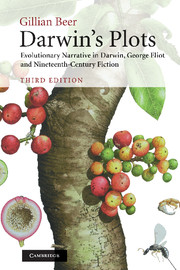Book contents
- Frontmatter
- Contents
- Foreword by George Levine
- Preface to the first edition
- Preface to the second edition
- Preface to the third edition
- Introduction
- Part I Darwin's language
- Part II Darwin's plots
- Part III Responses: George Eliot and Thomas Hardy
- Notes
- Select bibliography of primary works
- Further reading related to Charles Darwin
- Index
Introduction
Published online by Cambridge University Press: 04 August 2010
- Frontmatter
- Contents
- Foreword by George Levine
- Preface to the first edition
- Preface to the second edition
- Preface to the third edition
- Introduction
- Part I Darwin's language
- Part II Darwin's plots
- Part III Responses: George Eliot and Thomas Hardy
- Notes
- Select bibliography of primary works
- Further reading related to Charles Darwin
- Index
Summary
THE REMNANT OF THE MYTHICAL
Most major scientific theories rebuff common sense. They call on evidence beyond the reach of our senses and overturn the observable world. They disturb assumed relationships and shift what has been substantial into metaphor. The earth now only seems immovable. Such major theories tax, affront, and exhilarate those who first encounter them, although in fifty years or so they will be taken for granted, part of the apparently common-sense set of beliefs which instructs us that the earth revolves around the sun whatever our eyes may suggest. When it is first advanced, theory is at its most fictive. The awkwardness of fit between the natural world as it is currently perceived and as it is hypothetically imagined holds the theory itself for a time within a provisional scope akin to that of fiction. Throughout the 1850s and well into the 1860s, for example, evolutionary theory was commonly referred to as ‘the Development Hypothesis’.
In The Structure of Scientific Revolutions Kuhn discusses this phase in the conception and reception of a new scientific idea:
Discovery commences with the awareness of anomaly, i.e. with the recognition that nature has somehow violated the paradigm-induced expectations that govern normal science. It then continues with a more or less extended exploration of the area of anomaly. And it closes only when the paradigm theory has been adjusted so that the anomalous becomes the expected. Assimilating a new sort of fact demands a more than additive adjustment of theory, and until that adjustment is completed – until the scientist has learned to see nature in a different way – the new fact is not quite a scientific fact at all.
- Type
- Chapter
- Information
- Darwin's PlotsEvolutionary Narrative in Darwin, George Eliot and Nineteenth-Century Fiction, pp. 1 - 22Publisher: Cambridge University PressPrint publication year: 2009



